How Resilient Are Australian Cities? Climate Change Adaptation
VerifiedAdded on 2023/06/18
|15
|5498
|325
Essay
AI Summary
This essay explores the resilience of Australian cities in the face of climate change, highlighting the importance of urban planning and disaster management. It reviews literature on resilience and vulnerability assessments, emphasizing their role in preparing for and adapting to climate-related threats such as floods, bushfires, and cyclones. The study also discusses methods for enhancing urban resilience, including the development of climate-resilient housing and electrification initiatives, with a focus on Melbourne's strategies and its sister city relationship with Thessaloniki, Greece. The essay underscores the necessity of coordinated planning and the effective use of technology to mitigate the impacts of climate change and maintain urban efficiency. Desklib offers a range of study tools and resources for students.
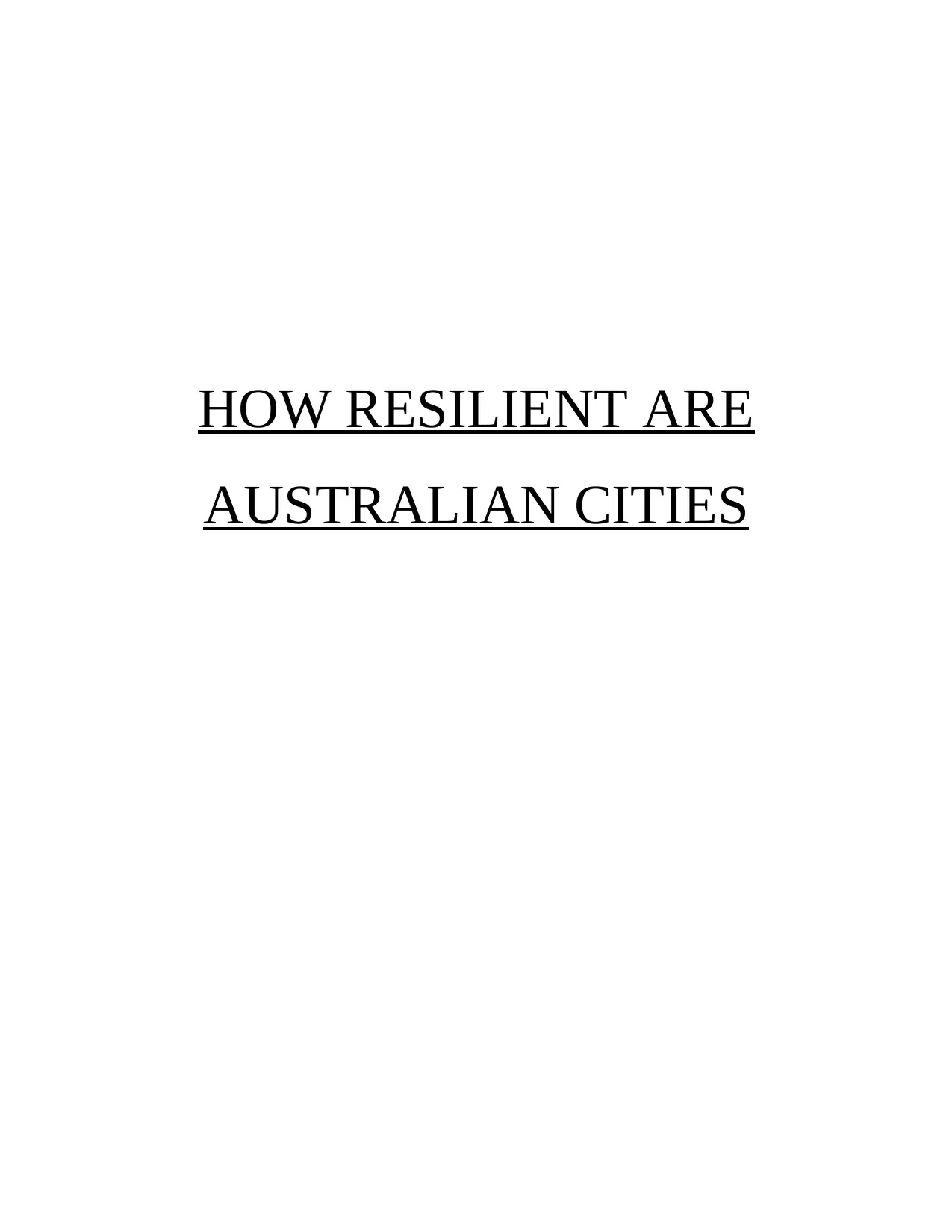
HOW RESILIENT ARE
AUSTRALIAN CITIES
AUSTRALIAN CITIES
Secure Best Marks with AI Grader
Need help grading? Try our AI Grader for instant feedback on your assignments.
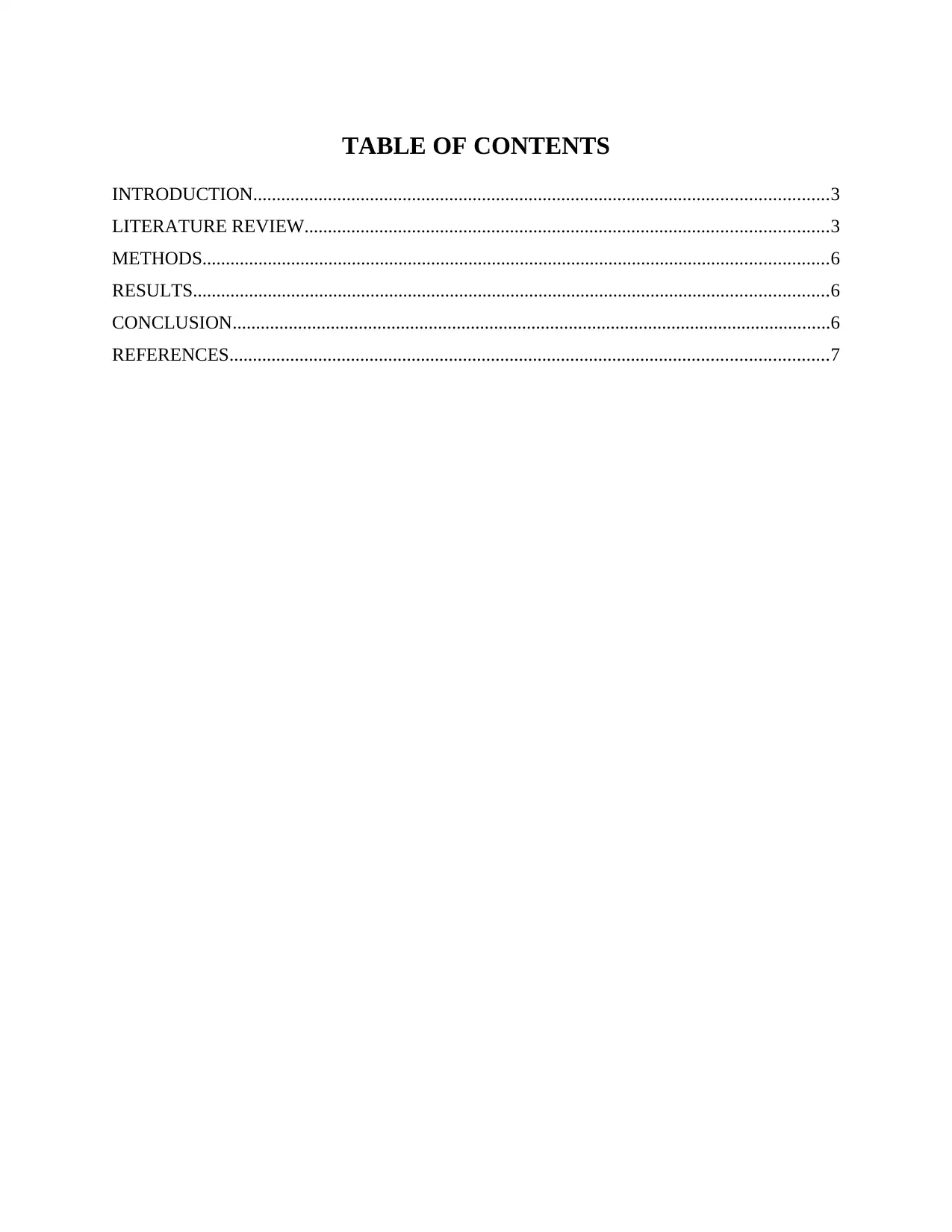
TABLE OF CONTENTS
INTRODUCTION...........................................................................................................................3
LITERATURE REVIEW................................................................................................................3
METHODS......................................................................................................................................6
RESULTS........................................................................................................................................6
CONCLUSION................................................................................................................................6
REFERENCES................................................................................................................................7
INTRODUCTION...........................................................................................................................3
LITERATURE REVIEW................................................................................................................3
METHODS......................................................................................................................................6
RESULTS........................................................................................................................................6
CONCLUSION................................................................................................................................6
REFERENCES................................................................................................................................7
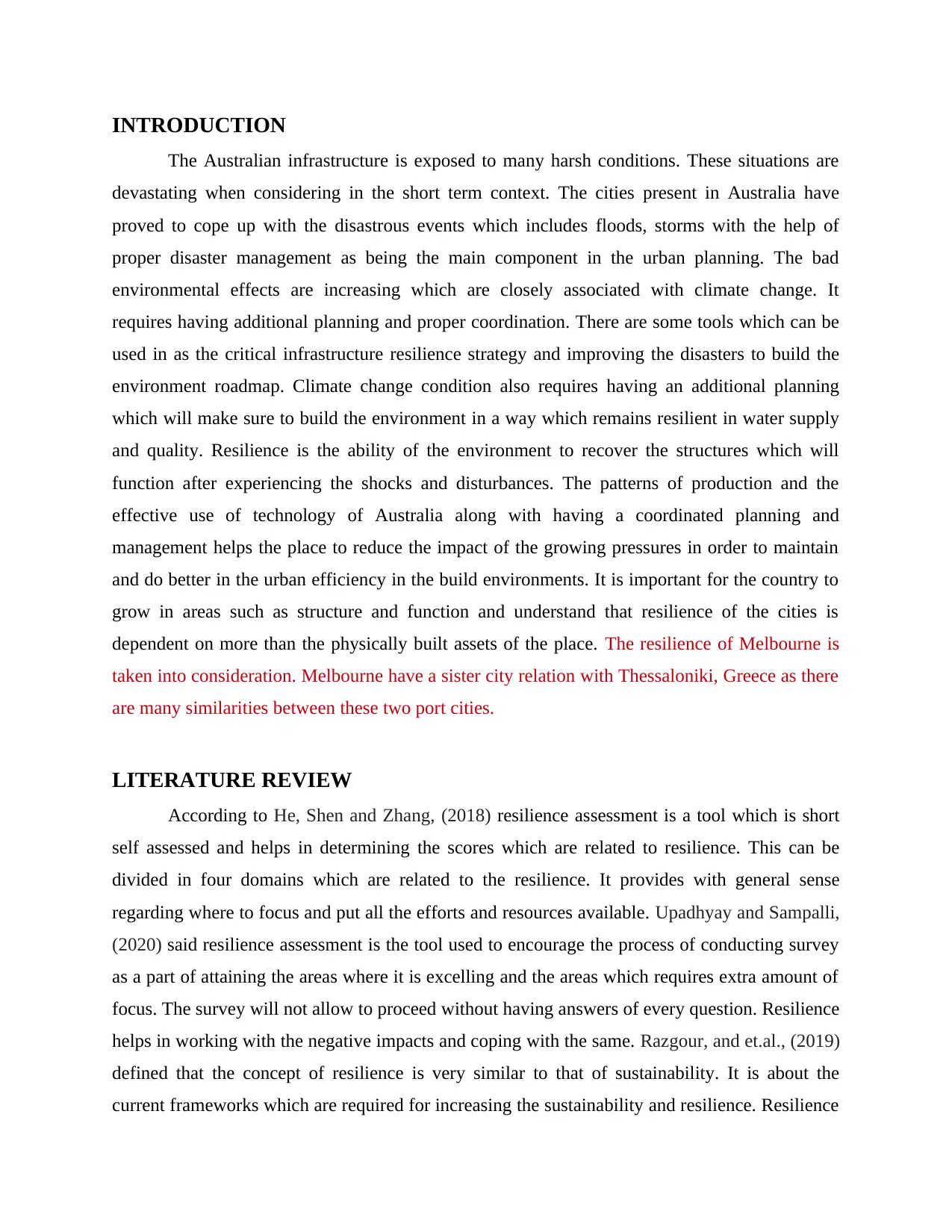
INTRODUCTION
The Australian infrastructure is exposed to many harsh conditions. These situations are
devastating when considering in the short term context. The cities present in Australia have
proved to cope up with the disastrous events which includes floods, storms with the help of
proper disaster management as being the main component in the urban planning. The bad
environmental effects are increasing which are closely associated with climate change. It
requires having additional planning and proper coordination. There are some tools which can be
used in as the critical infrastructure resilience strategy and improving the disasters to build the
environment roadmap. Climate change condition also requires having an additional planning
which will make sure to build the environment in a way which remains resilient in water supply
and quality. Resilience is the ability of the environment to recover the structures which will
function after experiencing the shocks and disturbances. The patterns of production and the
effective use of technology of Australia along with having a coordinated planning and
management helps the place to reduce the impact of the growing pressures in order to maintain
and do better in the urban efficiency in the build environments. It is important for the country to
grow in areas such as structure and function and understand that resilience of the cities is
dependent on more than the physically built assets of the place. The resilience of Melbourne is
taken into consideration. Melbourne have a sister city relation with Thessaloniki, Greece as there
are many similarities between these two port cities.
LITERATURE REVIEW
According to He, Shen and Zhang, (2018) resilience assessment is a tool which is short
self assessed and helps in determining the scores which are related to resilience. This can be
divided in four domains which are related to the resilience. It provides with general sense
regarding where to focus and put all the efforts and resources available. Upadhyay and Sampalli,
(2020) said resilience assessment is the tool used to encourage the process of conducting survey
as a part of attaining the areas where it is excelling and the areas which requires extra amount of
focus. The survey will not allow to proceed without having answers of every question. Resilience
helps in working with the negative impacts and coping with the same. Razgour, and et.al., (2019)
defined that the concept of resilience is very similar to that of sustainability. It is about the
current frameworks which are required for increasing the sustainability and resilience. Resilience
The Australian infrastructure is exposed to many harsh conditions. These situations are
devastating when considering in the short term context. The cities present in Australia have
proved to cope up with the disastrous events which includes floods, storms with the help of
proper disaster management as being the main component in the urban planning. The bad
environmental effects are increasing which are closely associated with climate change. It
requires having additional planning and proper coordination. There are some tools which can be
used in as the critical infrastructure resilience strategy and improving the disasters to build the
environment roadmap. Climate change condition also requires having an additional planning
which will make sure to build the environment in a way which remains resilient in water supply
and quality. Resilience is the ability of the environment to recover the structures which will
function after experiencing the shocks and disturbances. The patterns of production and the
effective use of technology of Australia along with having a coordinated planning and
management helps the place to reduce the impact of the growing pressures in order to maintain
and do better in the urban efficiency in the build environments. It is important for the country to
grow in areas such as structure and function and understand that resilience of the cities is
dependent on more than the physically built assets of the place. The resilience of Melbourne is
taken into consideration. Melbourne have a sister city relation with Thessaloniki, Greece as there
are many similarities between these two port cities.
LITERATURE REVIEW
According to He, Shen and Zhang, (2018) resilience assessment is a tool which is short
self assessed and helps in determining the scores which are related to resilience. This can be
divided in four domains which are related to the resilience. It provides with general sense
regarding where to focus and put all the efforts and resources available. Upadhyay and Sampalli,
(2020) said resilience assessment is the tool used to encourage the process of conducting survey
as a part of attaining the areas where it is excelling and the areas which requires extra amount of
focus. The survey will not allow to proceed without having answers of every question. Resilience
helps in working with the negative impacts and coping with the same. Razgour, and et.al., (2019)
defined that the concept of resilience is very similar to that of sustainability. It is about the
current frameworks which are required for increasing the sustainability and resilience. Resilience
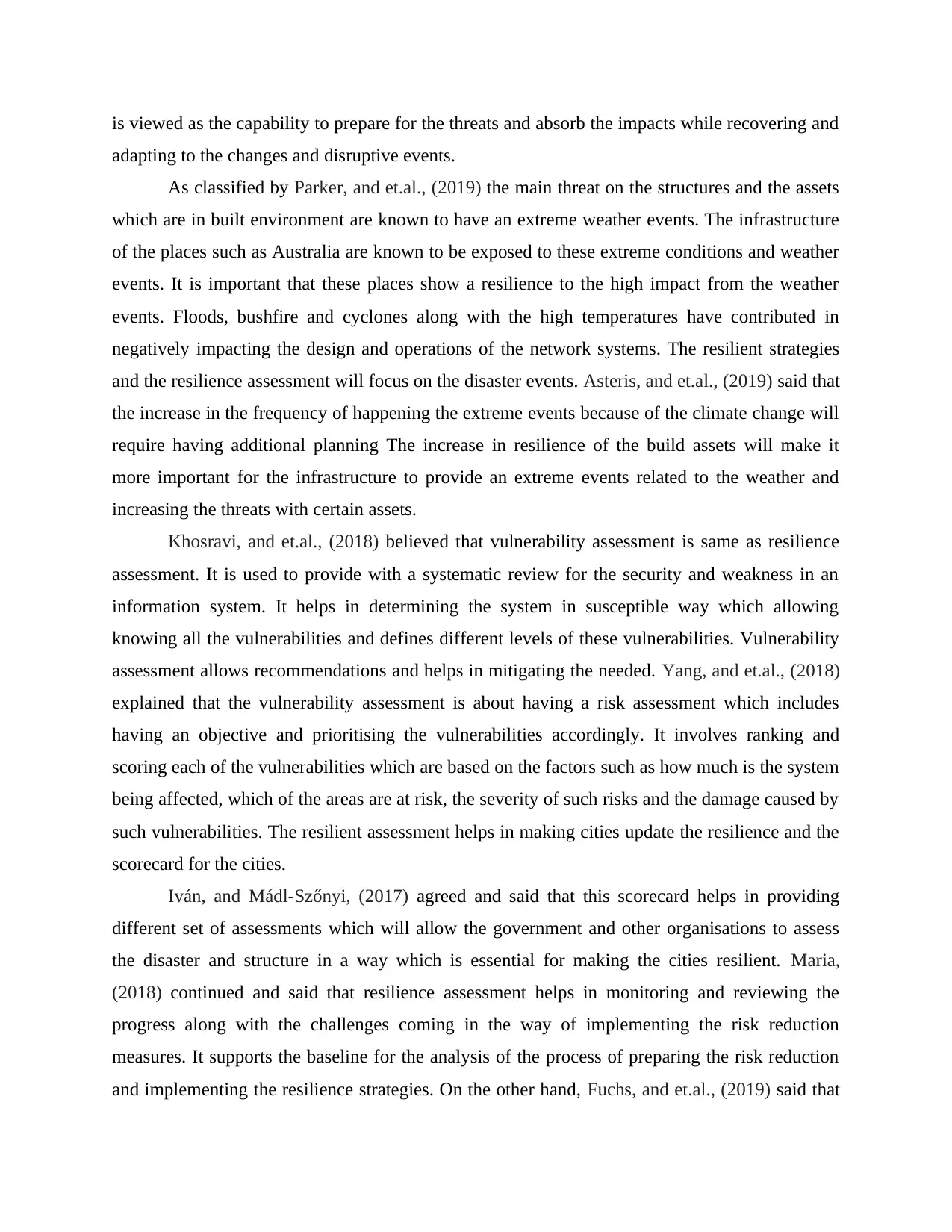
is viewed as the capability to prepare for the threats and absorb the impacts while recovering and
adapting to the changes and disruptive events.
As classified by Parker, and et.al., (2019) the main threat on the structures and the assets
which are in built environment are known to have an extreme weather events. The infrastructure
of the places such as Australia are known to be exposed to these extreme conditions and weather
events. It is important that these places show a resilience to the high impact from the weather
events. Floods, bushfire and cyclones along with the high temperatures have contributed in
negatively impacting the design and operations of the network systems. The resilient strategies
and the resilience assessment will focus on the disaster events. Asteris, and et.al., (2019) said that
the increase in the frequency of happening the extreme events because of the climate change will
require having additional planning The increase in resilience of the build assets will make it
more important for the infrastructure to provide an extreme events related to the weather and
increasing the threats with certain assets.
Khosravi, and et.al., (2018) believed that vulnerability assessment is same as resilience
assessment. It is used to provide with a systematic review for the security and weakness in an
information system. It helps in determining the system in susceptible way which allowing
knowing all the vulnerabilities and defines different levels of these vulnerabilities. Vulnerability
assessment allows recommendations and helps in mitigating the needed. Yang, and et.al., (2018)
explained that the vulnerability assessment is about having a risk assessment which includes
having an objective and prioritising the vulnerabilities accordingly. It involves ranking and
scoring each of the vulnerabilities which are based on the factors such as how much is the system
being affected, which of the areas are at risk, the severity of such risks and the damage caused by
such vulnerabilities. The resilient assessment helps in making cities update the resilience and the
scorecard for the cities.
Iván, and Mádl-Szőnyi, (2017) agreed and said that this scorecard helps in providing
different set of assessments which will allow the government and other organisations to assess
the disaster and structure in a way which is essential for making the cities resilient. Maria,
(2018) continued and said that resilience assessment helps in monitoring and reviewing the
progress along with the challenges coming in the way of implementing the risk reduction
measures. It supports the baseline for the analysis of the process of preparing the risk reduction
and implementing the resilience strategies. On the other hand, Fuchs, and et.al., (2019) said that
adapting to the changes and disruptive events.
As classified by Parker, and et.al., (2019) the main threat on the structures and the assets
which are in built environment are known to have an extreme weather events. The infrastructure
of the places such as Australia are known to be exposed to these extreme conditions and weather
events. It is important that these places show a resilience to the high impact from the weather
events. Floods, bushfire and cyclones along with the high temperatures have contributed in
negatively impacting the design and operations of the network systems. The resilient strategies
and the resilience assessment will focus on the disaster events. Asteris, and et.al., (2019) said that
the increase in the frequency of happening the extreme events because of the climate change will
require having additional planning The increase in resilience of the build assets will make it
more important for the infrastructure to provide an extreme events related to the weather and
increasing the threats with certain assets.
Khosravi, and et.al., (2018) believed that vulnerability assessment is same as resilience
assessment. It is used to provide with a systematic review for the security and weakness in an
information system. It helps in determining the system in susceptible way which allowing
knowing all the vulnerabilities and defines different levels of these vulnerabilities. Vulnerability
assessment allows recommendations and helps in mitigating the needed. Yang, and et.al., (2018)
explained that the vulnerability assessment is about having a risk assessment which includes
having an objective and prioritising the vulnerabilities accordingly. It involves ranking and
scoring each of the vulnerabilities which are based on the factors such as how much is the system
being affected, which of the areas are at risk, the severity of such risks and the damage caused by
such vulnerabilities. The resilient assessment helps in making cities update the resilience and the
scorecard for the cities.
Iván, and Mádl-Szőnyi, (2017) agreed and said that this scorecard helps in providing
different set of assessments which will allow the government and other organisations to assess
the disaster and structure in a way which is essential for making the cities resilient. Maria,
(2018) continued and said that resilience assessment helps in monitoring and reviewing the
progress along with the challenges coming in the way of implementing the risk reduction
measures. It supports the baseline for the analysis of the process of preparing the risk reduction
and implementing the resilience strategies. On the other hand, Fuchs, and et.al., (2019) said that
Secure Best Marks with AI Grader
Need help grading? Try our AI Grader for instant feedback on your assignments.
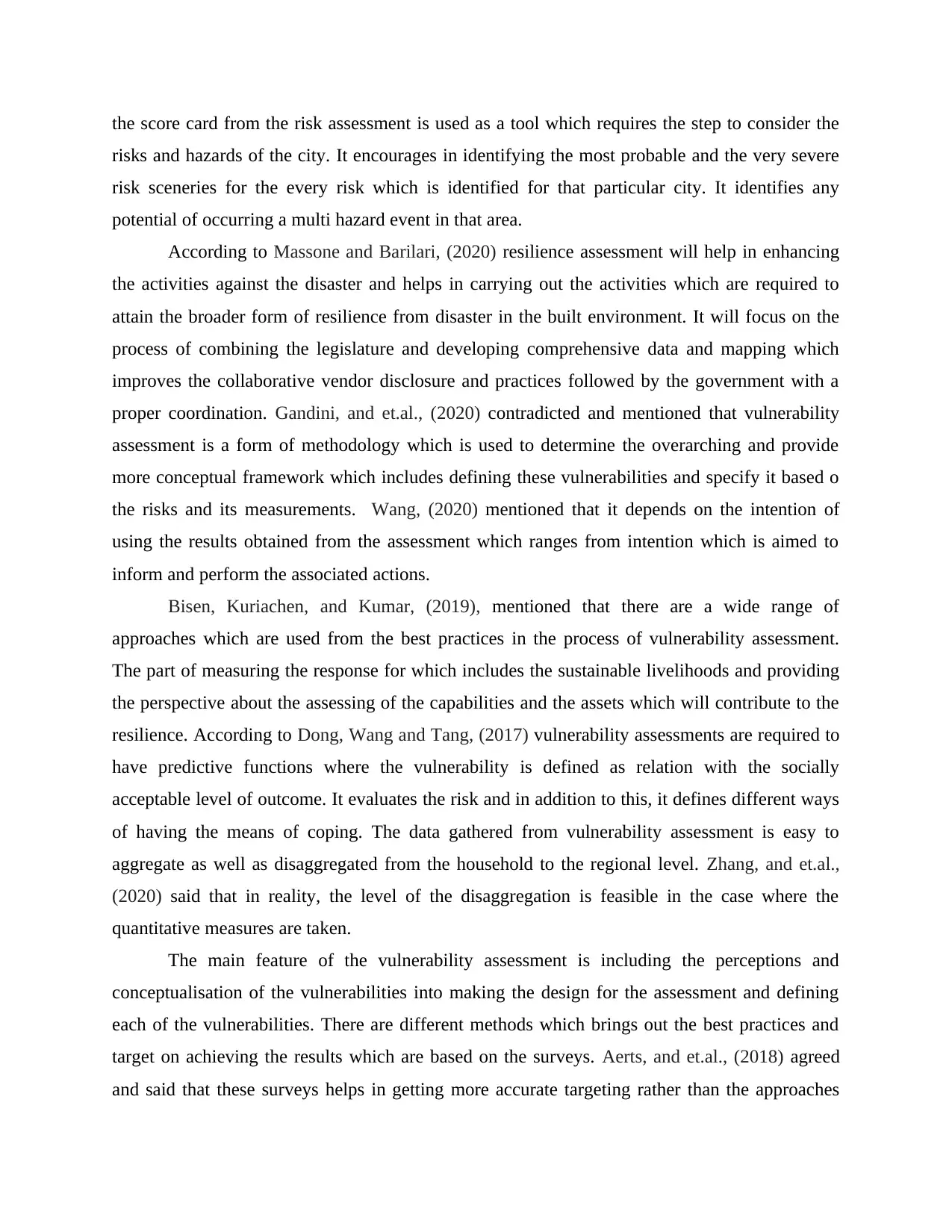
the score card from the risk assessment is used as a tool which requires the step to consider the
risks and hazards of the city. It encourages in identifying the most probable and the very severe
risk sceneries for the every risk which is identified for that particular city. It identifies any
potential of occurring a multi hazard event in that area.
According to Massone and Barilari, (2020) resilience assessment will help in enhancing
the activities against the disaster and helps in carrying out the activities which are required to
attain the broader form of resilience from disaster in the built environment. It will focus on the
process of combining the legislature and developing comprehensive data and mapping which
improves the collaborative vendor disclosure and practices followed by the government with a
proper coordination. Gandini, and et.al., (2020) contradicted and mentioned that vulnerability
assessment is a form of methodology which is used to determine the overarching and provide
more conceptual framework which includes defining these vulnerabilities and specify it based o
the risks and its measurements. Wang, (2020) mentioned that it depends on the intention of
using the results obtained from the assessment which ranges from intention which is aimed to
inform and perform the associated actions.
Bisen, Kuriachen, and Kumar, (2019), mentioned that there are a wide range of
approaches which are used from the best practices in the process of vulnerability assessment.
The part of measuring the response for which includes the sustainable livelihoods and providing
the perspective about the assessing of the capabilities and the assets which will contribute to the
resilience. According to Dong, Wang and Tang, (2017) vulnerability assessments are required to
have predictive functions where the vulnerability is defined as relation with the socially
acceptable level of outcome. It evaluates the risk and in addition to this, it defines different ways
of having the means of coping. The data gathered from vulnerability assessment is easy to
aggregate as well as disaggregated from the household to the regional level. Zhang, and et.al.,
(2020) said that in reality, the level of the disaggregation is feasible in the case where the
quantitative measures are taken.
The main feature of the vulnerability assessment is including the perceptions and
conceptualisation of the vulnerabilities into making the design for the assessment and defining
each of the vulnerabilities. There are different methods which brings out the best practices and
target on achieving the results which are based on the surveys. Aerts, and et.al., (2018) agreed
and said that these surveys helps in getting more accurate targeting rather than the approaches
risks and hazards of the city. It encourages in identifying the most probable and the very severe
risk sceneries for the every risk which is identified for that particular city. It identifies any
potential of occurring a multi hazard event in that area.
According to Massone and Barilari, (2020) resilience assessment will help in enhancing
the activities against the disaster and helps in carrying out the activities which are required to
attain the broader form of resilience from disaster in the built environment. It will focus on the
process of combining the legislature and developing comprehensive data and mapping which
improves the collaborative vendor disclosure and practices followed by the government with a
proper coordination. Gandini, and et.al., (2020) contradicted and mentioned that vulnerability
assessment is a form of methodology which is used to determine the overarching and provide
more conceptual framework which includes defining these vulnerabilities and specify it based o
the risks and its measurements. Wang, (2020) mentioned that it depends on the intention of
using the results obtained from the assessment which ranges from intention which is aimed to
inform and perform the associated actions.
Bisen, Kuriachen, and Kumar, (2019), mentioned that there are a wide range of
approaches which are used from the best practices in the process of vulnerability assessment.
The part of measuring the response for which includes the sustainable livelihoods and providing
the perspective about the assessing of the capabilities and the assets which will contribute to the
resilience. According to Dong, Wang and Tang, (2017) vulnerability assessments are required to
have predictive functions where the vulnerability is defined as relation with the socially
acceptable level of outcome. It evaluates the risk and in addition to this, it defines different ways
of having the means of coping. The data gathered from vulnerability assessment is easy to
aggregate as well as disaggregated from the household to the regional level. Zhang, and et.al.,
(2020) said that in reality, the level of the disaggregation is feasible in the case where the
quantitative measures are taken.
The main feature of the vulnerability assessment is including the perceptions and
conceptualisation of the vulnerabilities into making the design for the assessment and defining
each of the vulnerabilities. There are different methods which brings out the best practices and
target on achieving the results which are based on the surveys. Aerts, and et.al., (2018) agreed
and said that these surveys helps in getting more accurate targeting rather than the approaches
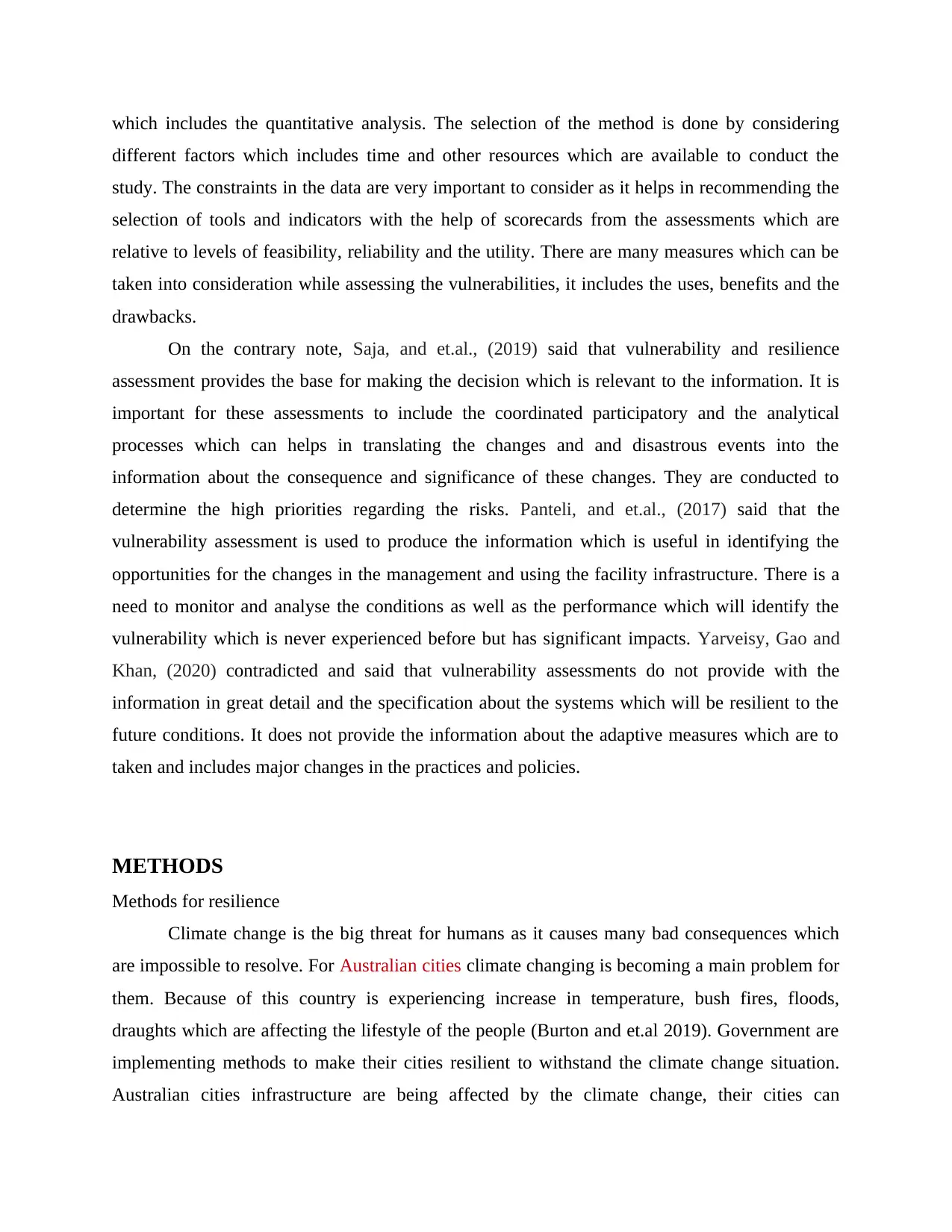
which includes the quantitative analysis. The selection of the method is done by considering
different factors which includes time and other resources which are available to conduct the
study. The constraints in the data are very important to consider as it helps in recommending the
selection of tools and indicators with the help of scorecards from the assessments which are
relative to levels of feasibility, reliability and the utility. There are many measures which can be
taken into consideration while assessing the vulnerabilities, it includes the uses, benefits and the
drawbacks.
On the contrary note, Saja, and et.al., (2019) said that vulnerability and resilience
assessment provides the base for making the decision which is relevant to the information. It is
important for these assessments to include the coordinated participatory and the analytical
processes which can helps in translating the changes and and disastrous events into the
information about the consequence and significance of these changes. They are conducted to
determine the high priorities regarding the risks. Panteli, and et.al., (2017) said that the
vulnerability assessment is used to produce the information which is useful in identifying the
opportunities for the changes in the management and using the facility infrastructure. There is a
need to monitor and analyse the conditions as well as the performance which will identify the
vulnerability which is never experienced before but has significant impacts. Yarveisy, Gao and
Khan, (2020) contradicted and said that vulnerability assessments do not provide with the
information in great detail and the specification about the systems which will be resilient to the
future conditions. It does not provide the information about the adaptive measures which are to
taken and includes major changes in the practices and policies.
METHODS
Methods for resilience
Climate change is the big threat for humans as it causes many bad consequences which
are impossible to resolve. For Australian cities climate changing is becoming a main problem for
them. Because of this country is experiencing increase in temperature, bush fires, floods,
draughts which are affecting the lifestyle of the people (Burton and et.al 2019). Government are
implementing methods to make their cities resilient to withstand the climate change situation.
Australian cities infrastructure are being affected by the climate change, their cities can
different factors which includes time and other resources which are available to conduct the
study. The constraints in the data are very important to consider as it helps in recommending the
selection of tools and indicators with the help of scorecards from the assessments which are
relative to levels of feasibility, reliability and the utility. There are many measures which can be
taken into consideration while assessing the vulnerabilities, it includes the uses, benefits and the
drawbacks.
On the contrary note, Saja, and et.al., (2019) said that vulnerability and resilience
assessment provides the base for making the decision which is relevant to the information. It is
important for these assessments to include the coordinated participatory and the analytical
processes which can helps in translating the changes and and disastrous events into the
information about the consequence and significance of these changes. They are conducted to
determine the high priorities regarding the risks. Panteli, and et.al., (2017) said that the
vulnerability assessment is used to produce the information which is useful in identifying the
opportunities for the changes in the management and using the facility infrastructure. There is a
need to monitor and analyse the conditions as well as the performance which will identify the
vulnerability which is never experienced before but has significant impacts. Yarveisy, Gao and
Khan, (2020) contradicted and said that vulnerability assessments do not provide with the
information in great detail and the specification about the systems which will be resilient to the
future conditions. It does not provide the information about the adaptive measures which are to
taken and includes major changes in the practices and policies.
METHODS
Methods for resilience
Climate change is the big threat for humans as it causes many bad consequences which
are impossible to resolve. For Australian cities climate changing is becoming a main problem for
them. Because of this country is experiencing increase in temperature, bush fires, floods,
draughts which are affecting the lifestyle of the people (Burton and et.al 2019). Government are
implementing methods to make their cities resilient to withstand the climate change situation.
Australian cities infrastructure are being affected by the climate change, their cities can
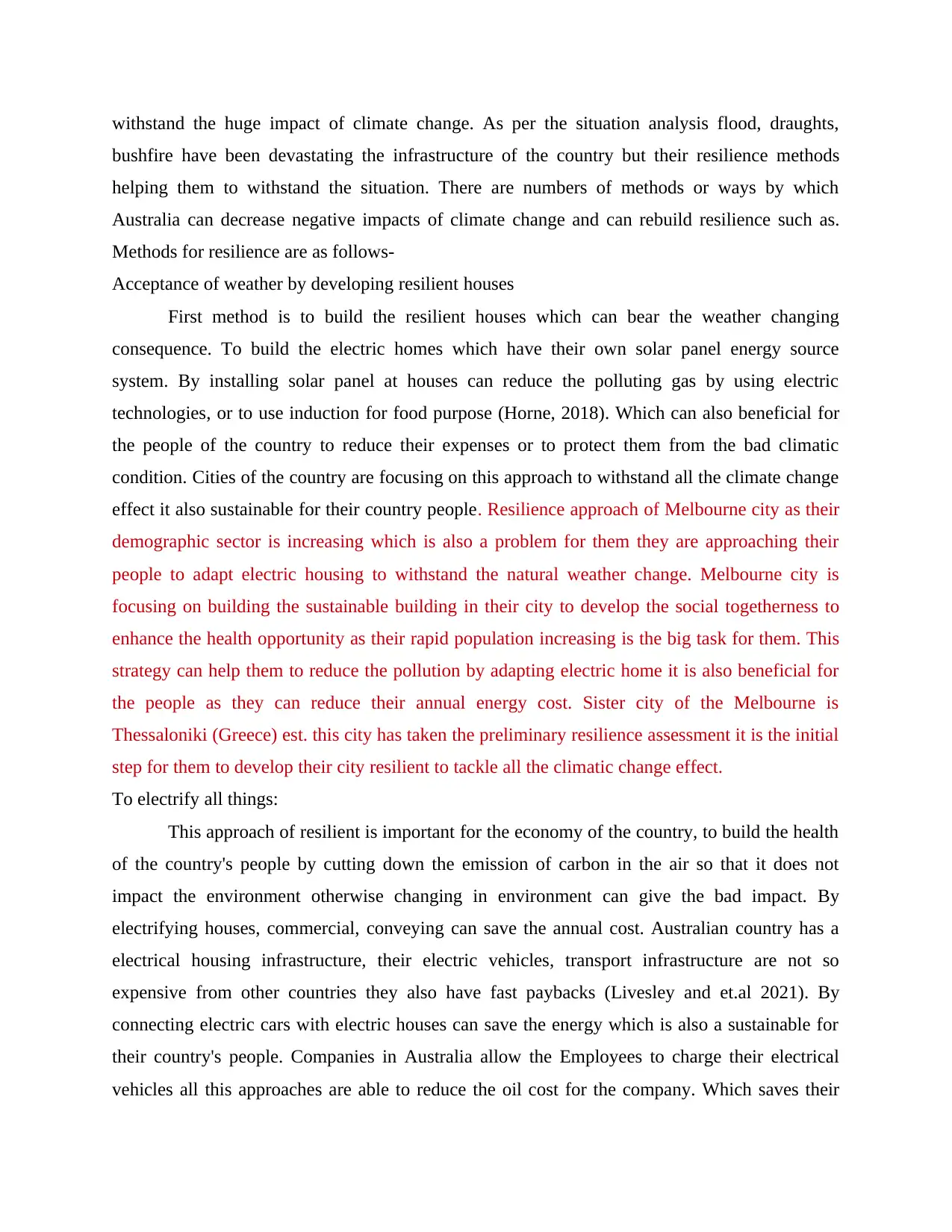
withstand the huge impact of climate change. As per the situation analysis flood, draughts,
bushfire have been devastating the infrastructure of the country but their resilience methods
helping them to withstand the situation. There are numbers of methods or ways by which
Australia can decrease negative impacts of climate change and can rebuild resilience such as.
Methods for resilience are as follows-
Acceptance of weather by developing resilient houses
First method is to build the resilient houses which can bear the weather changing
consequence. To build the electric homes which have their own solar panel energy source
system. By installing solar panel at houses can reduce the polluting gas by using electric
technologies, or to use induction for food purpose (Horne, 2018). Which can also beneficial for
the people of the country to reduce their expenses or to protect them from the bad climatic
condition. Cities of the country are focusing on this approach to withstand all the climate change
effect it also sustainable for their country people. Resilience approach of Melbourne city as their
demographic sector is increasing which is also a problem for them they are approaching their
people to adapt electric housing to withstand the natural weather change. Melbourne city is
focusing on building the sustainable building in their city to develop the social togetherness to
enhance the health opportunity as their rapid population increasing is the big task for them. This
strategy can help them to reduce the pollution by adapting electric home it is also beneficial for
the people as they can reduce their annual energy cost. Sister city of the Melbourne is
Thessaloniki (Greece) est. this city has taken the preliminary resilience assessment it is the initial
step for them to develop their city resilient to tackle all the climatic change effect.
To electrify all things:
This approach of resilient is important for the economy of the country, to build the health
of the country's people by cutting down the emission of carbon in the air so that it does not
impact the environment otherwise changing in environment can give the bad impact. By
electrifying houses, commercial, conveying can save the annual cost. Australian country has a
electrical housing infrastructure, their electric vehicles, transport infrastructure are not so
expensive from other countries they also have fast paybacks (Livesley and et.al 2021). By
connecting electric cars with electric houses can save the energy which is also a sustainable for
their country's people. Companies in Australia allow the Employees to charge their electrical
vehicles all this approaches are able to reduce the oil cost for the company. Which saves their
bushfire have been devastating the infrastructure of the country but their resilience methods
helping them to withstand the situation. There are numbers of methods or ways by which
Australia can decrease negative impacts of climate change and can rebuild resilience such as.
Methods for resilience are as follows-
Acceptance of weather by developing resilient houses
First method is to build the resilient houses which can bear the weather changing
consequence. To build the electric homes which have their own solar panel energy source
system. By installing solar panel at houses can reduce the polluting gas by using electric
technologies, or to use induction for food purpose (Horne, 2018). Which can also beneficial for
the people of the country to reduce their expenses or to protect them from the bad climatic
condition. Cities of the country are focusing on this approach to withstand all the climate change
effect it also sustainable for their country people. Resilience approach of Melbourne city as their
demographic sector is increasing which is also a problem for them they are approaching their
people to adapt electric housing to withstand the natural weather change. Melbourne city is
focusing on building the sustainable building in their city to develop the social togetherness to
enhance the health opportunity as their rapid population increasing is the big task for them. This
strategy can help them to reduce the pollution by adapting electric home it is also beneficial for
the people as they can reduce their annual energy cost. Sister city of the Melbourne is
Thessaloniki (Greece) est. this city has taken the preliminary resilience assessment it is the initial
step for them to develop their city resilient to tackle all the climatic change effect.
To electrify all things:
This approach of resilient is important for the economy of the country, to build the health
of the country's people by cutting down the emission of carbon in the air so that it does not
impact the environment otherwise changing in environment can give the bad impact. By
electrifying houses, commercial, conveying can save the annual cost. Australian country has a
electrical housing infrastructure, their electric vehicles, transport infrastructure are not so
expensive from other countries they also have fast paybacks (Livesley and et.al 2021). By
connecting electric cars with electric houses can save the energy which is also a sustainable for
their country's people. Companies in Australia allow the Employees to charge their electrical
vehicles all this approaches are able to reduce the oil cost for the company. Which saves their
Paraphrase This Document
Need a fresh take? Get an instant paraphrase of this document with our AI Paraphraser
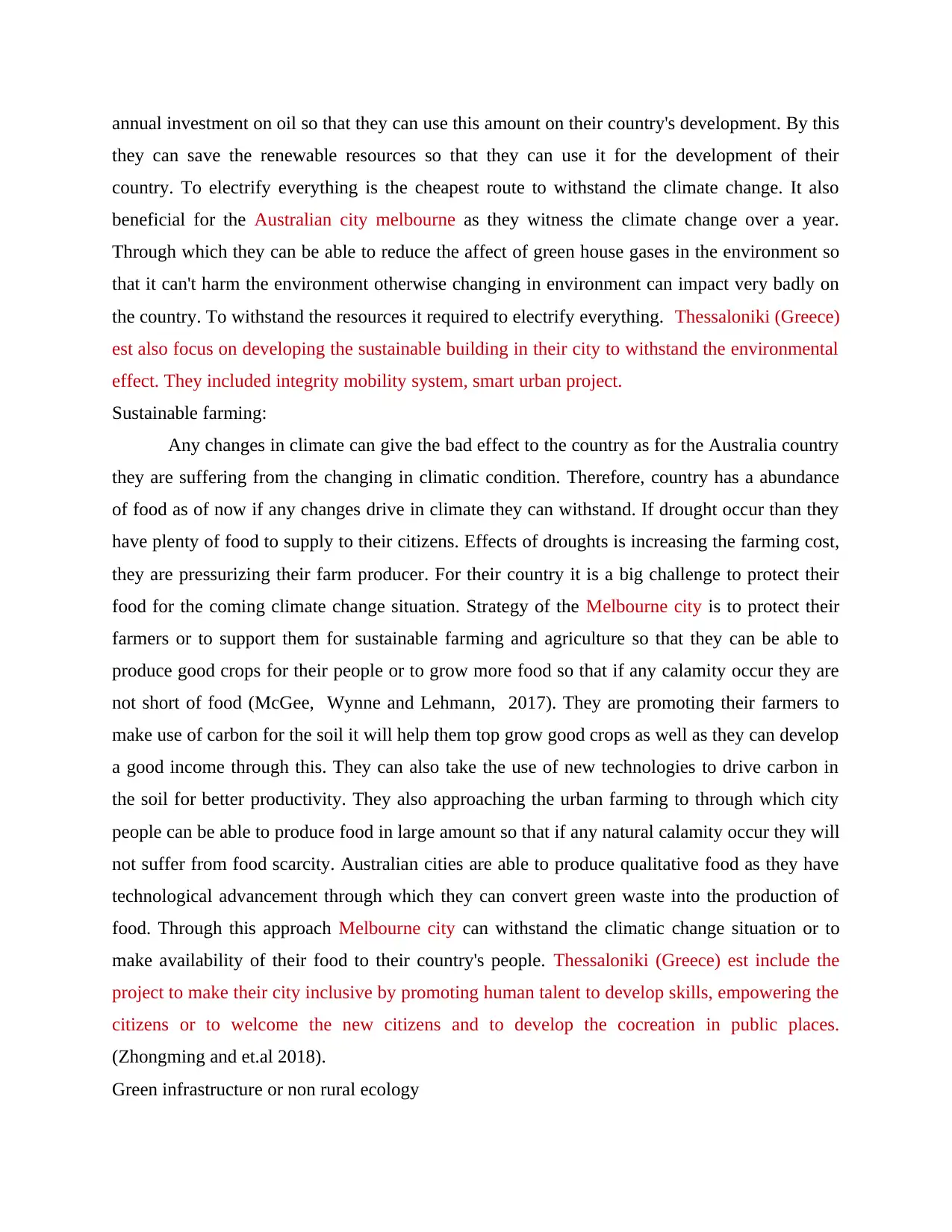
annual investment on oil so that they can use this amount on their country's development. By this
they can save the renewable resources so that they can use it for the development of their
country. To electrify everything is the cheapest route to withstand the climate change. It also
beneficial for the Australian city melbourne as they witness the climate change over a year.
Through which they can be able to reduce the affect of green house gases in the environment so
that it can't harm the environment otherwise changing in environment can impact very badly on
the country. To withstand the resources it required to electrify everything. Thessaloniki (Greece)
est also focus on developing the sustainable building in their city to withstand the environmental
effect. They included integrity mobility system, smart urban project.
Sustainable farming:
Any changes in climate can give the bad effect to the country as for the Australia country
they are suffering from the changing in climatic condition. Therefore, country has a abundance
of food as of now if any changes drive in climate they can withstand. If drought occur than they
have plenty of food to supply to their citizens. Effects of droughts is increasing the farming cost,
they are pressurizing their farm producer. For their country it is a big challenge to protect their
food for the coming climate change situation. Strategy of the Melbourne city is to protect their
farmers or to support them for sustainable farming and agriculture so that they can be able to
produce good crops for their people or to grow more food so that if any calamity occur they are
not short of food (McGee, Wynne and Lehmann, 2017). They are promoting their farmers to
make use of carbon for the soil it will help them top grow good crops as well as they can develop
a good income through this. They can also take the use of new technologies to drive carbon in
the soil for better productivity. They also approaching the urban farming to through which city
people can be able to produce food in large amount so that if any natural calamity occur they will
not suffer from food scarcity. Australian cities are able to produce qualitative food as they have
technological advancement through which they can convert green waste into the production of
food. Through this approach Melbourne city can withstand the climatic change situation or to
make availability of their food to their country's people. Thessaloniki (Greece) est include the
project to make their city inclusive by promoting human talent to develop skills, empowering the
citizens or to welcome the new citizens and to develop the cocreation in public places.
(Zhongming and et.al 2018).
Green infrastructure or non rural ecology
they can save the renewable resources so that they can use it for the development of their
country. To electrify everything is the cheapest route to withstand the climate change. It also
beneficial for the Australian city melbourne as they witness the climate change over a year.
Through which they can be able to reduce the affect of green house gases in the environment so
that it can't harm the environment otherwise changing in environment can impact very badly on
the country. To withstand the resources it required to electrify everything. Thessaloniki (Greece)
est also focus on developing the sustainable building in their city to withstand the environmental
effect. They included integrity mobility system, smart urban project.
Sustainable farming:
Any changes in climate can give the bad effect to the country as for the Australia country
they are suffering from the changing in climatic condition. Therefore, country has a abundance
of food as of now if any changes drive in climate they can withstand. If drought occur than they
have plenty of food to supply to their citizens. Effects of droughts is increasing the farming cost,
they are pressurizing their farm producer. For their country it is a big challenge to protect their
food for the coming climate change situation. Strategy of the Melbourne city is to protect their
farmers or to support them for sustainable farming and agriculture so that they can be able to
produce good crops for their people or to grow more food so that if any calamity occur they are
not short of food (McGee, Wynne and Lehmann, 2017). They are promoting their farmers to
make use of carbon for the soil it will help them top grow good crops as well as they can develop
a good income through this. They can also take the use of new technologies to drive carbon in
the soil for better productivity. They also approaching the urban farming to through which city
people can be able to produce food in large amount so that if any natural calamity occur they will
not suffer from food scarcity. Australian cities are able to produce qualitative food as they have
technological advancement through which they can convert green waste into the production of
food. Through this approach Melbourne city can withstand the climatic change situation or to
make availability of their food to their country's people. Thessaloniki (Greece) est include the
project to make their city inclusive by promoting human talent to develop skills, empowering the
citizens or to welcome the new citizens and to develop the cocreation in public places.
(Zhongming and et.al 2018).
Green infrastructure or non rural ecology
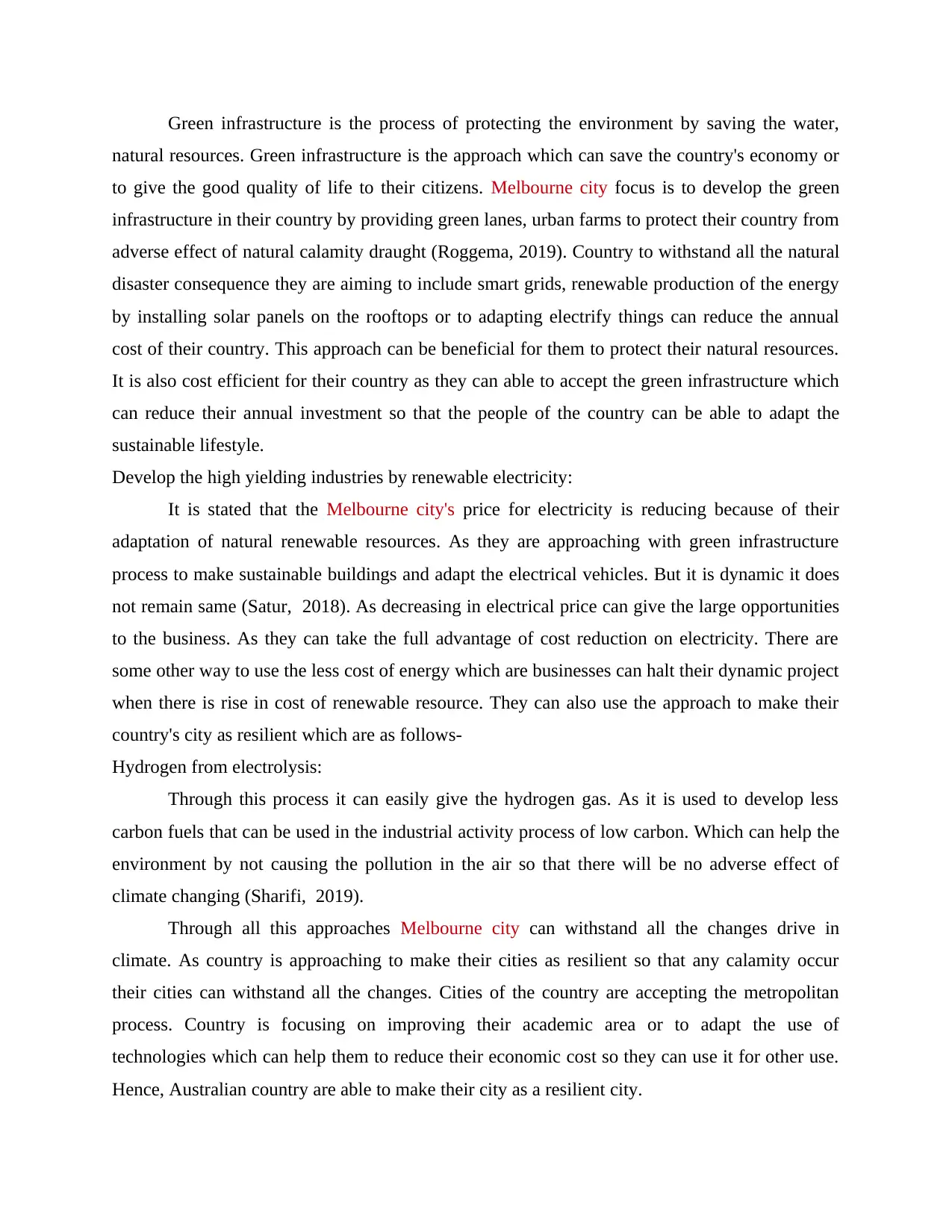
Green infrastructure is the process of protecting the environment by saving the water,
natural resources. Green infrastructure is the approach which can save the country's economy or
to give the good quality of life to their citizens. Melbourne city focus is to develop the green
infrastructure in their country by providing green lanes, urban farms to protect their country from
adverse effect of natural calamity draught (Roggema, 2019). Country to withstand all the natural
disaster consequence they are aiming to include smart grids, renewable production of the energy
by installing solar panels on the rooftops or to adapting electrify things can reduce the annual
cost of their country. This approach can be beneficial for them to protect their natural resources.
It is also cost efficient for their country as they can able to accept the green infrastructure which
can reduce their annual investment so that the people of the country can be able to adapt the
sustainable lifestyle.
Develop the high yielding industries by renewable electricity:
It is stated that the Melbourne city's price for electricity is reducing because of their
adaptation of natural renewable resources. As they are approaching with green infrastructure
process to make sustainable buildings and adapt the electrical vehicles. But it is dynamic it does
not remain same (Satur, 2018). As decreasing in electrical price can give the large opportunities
to the business. As they can take the full advantage of cost reduction on electricity. There are
some other way to use the less cost of energy which are businesses can halt their dynamic project
when there is rise in cost of renewable resource. They can also use the approach to make their
country's city as resilient which are as follows-
Hydrogen from electrolysis:
Through this process it can easily give the hydrogen gas. As it is used to develop less
carbon fuels that can be used in the industrial activity process of low carbon. Which can help the
environment by not causing the pollution in the air so that there will be no adverse effect of
climate changing (Sharifi, 2019).
Through all this approaches Melbourne city can withstand all the changes drive in
climate. As country is approaching to make their cities as resilient so that any calamity occur
their cities can withstand all the changes. Cities of the country are accepting the metropolitan
process. Country is focusing on improving their academic area or to adapt the use of
technologies which can help them to reduce their economic cost so they can use it for other use.
Hence, Australian country are able to make their city as a resilient city.
natural resources. Green infrastructure is the approach which can save the country's economy or
to give the good quality of life to their citizens. Melbourne city focus is to develop the green
infrastructure in their country by providing green lanes, urban farms to protect their country from
adverse effect of natural calamity draught (Roggema, 2019). Country to withstand all the natural
disaster consequence they are aiming to include smart grids, renewable production of the energy
by installing solar panels on the rooftops or to adapting electrify things can reduce the annual
cost of their country. This approach can be beneficial for them to protect their natural resources.
It is also cost efficient for their country as they can able to accept the green infrastructure which
can reduce their annual investment so that the people of the country can be able to adapt the
sustainable lifestyle.
Develop the high yielding industries by renewable electricity:
It is stated that the Melbourne city's price for electricity is reducing because of their
adaptation of natural renewable resources. As they are approaching with green infrastructure
process to make sustainable buildings and adapt the electrical vehicles. But it is dynamic it does
not remain same (Satur, 2018). As decreasing in electrical price can give the large opportunities
to the business. As they can take the full advantage of cost reduction on electricity. There are
some other way to use the less cost of energy which are businesses can halt their dynamic project
when there is rise in cost of renewable resource. They can also use the approach to make their
country's city as resilient which are as follows-
Hydrogen from electrolysis:
Through this process it can easily give the hydrogen gas. As it is used to develop less
carbon fuels that can be used in the industrial activity process of low carbon. Which can help the
environment by not causing the pollution in the air so that there will be no adverse effect of
climate changing (Sharifi, 2019).
Through all this approaches Melbourne city can withstand all the changes drive in
climate. As country is approaching to make their cities as resilient so that any calamity occur
their cities can withstand all the changes. Cities of the country are accepting the metropolitan
process. Country is focusing on improving their academic area or to adapt the use of
technologies which can help them to reduce their economic cost so they can use it for other use.
Hence, Australian country are able to make their city as a resilient city.
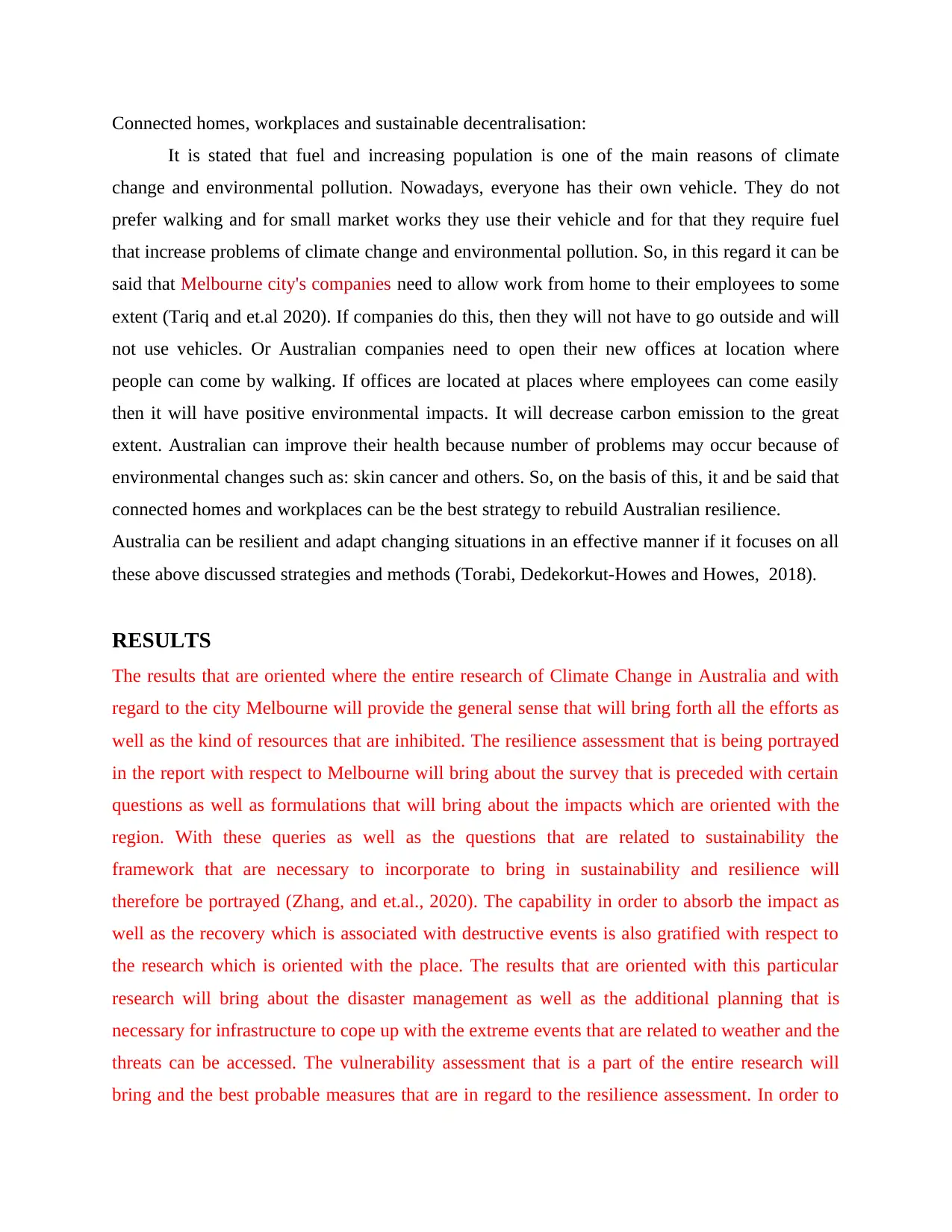
Connected homes, workplaces and sustainable decentralisation:
It is stated that fuel and increasing population is one of the main reasons of climate
change and environmental pollution. Nowadays, everyone has their own vehicle. They do not
prefer walking and for small market works they use their vehicle and for that they require fuel
that increase problems of climate change and environmental pollution. So, in this regard it can be
said that Melbourne city's companies need to allow work from home to their employees to some
extent (Tariq and et.al 2020). If companies do this, then they will not have to go outside and will
not use vehicles. Or Australian companies need to open their new offices at location where
people can come by walking. If offices are located at places where employees can come easily
then it will have positive environmental impacts. It will decrease carbon emission to the great
extent. Australian can improve their health because number of problems may occur because of
environmental changes such as: skin cancer and others. So, on the basis of this, it and be said that
connected homes and workplaces can be the best strategy to rebuild Australian resilience.
Australia can be resilient and adapt changing situations in an effective manner if it focuses on all
these above discussed strategies and methods (Torabi, Dedekorkut-Howes and Howes, 2018).
RESULTS
The results that are oriented where the entire research of Climate Change in Australia and with
regard to the city Melbourne will provide the general sense that will bring forth all the efforts as
well as the kind of resources that are inhibited. The resilience assessment that is being portrayed
in the report with respect to Melbourne will bring about the survey that is preceded with certain
questions as well as formulations that will bring about the impacts which are oriented with the
region. With these queries as well as the questions that are related to sustainability the
framework that are necessary to incorporate to bring in sustainability and resilience will
therefore be portrayed (Zhang, and et.al., 2020). The capability in order to absorb the impact as
well as the recovery which is associated with destructive events is also gratified with respect to
the research which is oriented with the place. The results that are oriented with this particular
research will bring about the disaster management as well as the additional planning that is
necessary for infrastructure to cope up with the extreme events that are related to weather and the
threats can be accessed. The vulnerability assessment that is a part of the entire research will
bring and the best probable measures that are in regard to the resilience assessment. In order to
It is stated that fuel and increasing population is one of the main reasons of climate
change and environmental pollution. Nowadays, everyone has their own vehicle. They do not
prefer walking and for small market works they use their vehicle and for that they require fuel
that increase problems of climate change and environmental pollution. So, in this regard it can be
said that Melbourne city's companies need to allow work from home to their employees to some
extent (Tariq and et.al 2020). If companies do this, then they will not have to go outside and will
not use vehicles. Or Australian companies need to open their new offices at location where
people can come by walking. If offices are located at places where employees can come easily
then it will have positive environmental impacts. It will decrease carbon emission to the great
extent. Australian can improve their health because number of problems may occur because of
environmental changes such as: skin cancer and others. So, on the basis of this, it and be said that
connected homes and workplaces can be the best strategy to rebuild Australian resilience.
Australia can be resilient and adapt changing situations in an effective manner if it focuses on all
these above discussed strategies and methods (Torabi, Dedekorkut-Howes and Howes, 2018).
RESULTS
The results that are oriented where the entire research of Climate Change in Australia and with
regard to the city Melbourne will provide the general sense that will bring forth all the efforts as
well as the kind of resources that are inhibited. The resilience assessment that is being portrayed
in the report with respect to Melbourne will bring about the survey that is preceded with certain
questions as well as formulations that will bring about the impacts which are oriented with the
region. With these queries as well as the questions that are related to sustainability the
framework that are necessary to incorporate to bring in sustainability and resilience will
therefore be portrayed (Zhang, and et.al., 2020). The capability in order to absorb the impact as
well as the recovery which is associated with destructive events is also gratified with respect to
the research which is oriented with the place. The results that are oriented with this particular
research will bring about the disaster management as well as the additional planning that is
necessary for infrastructure to cope up with the extreme events that are related to weather and the
threats can be accessed. The vulnerability assessment that is a part of the entire research will
bring and the best probable measures that are in regard to the resilience assessment. In order to
Secure Best Marks with AI Grader
Need help grading? Try our AI Grader for instant feedback on your assignments.
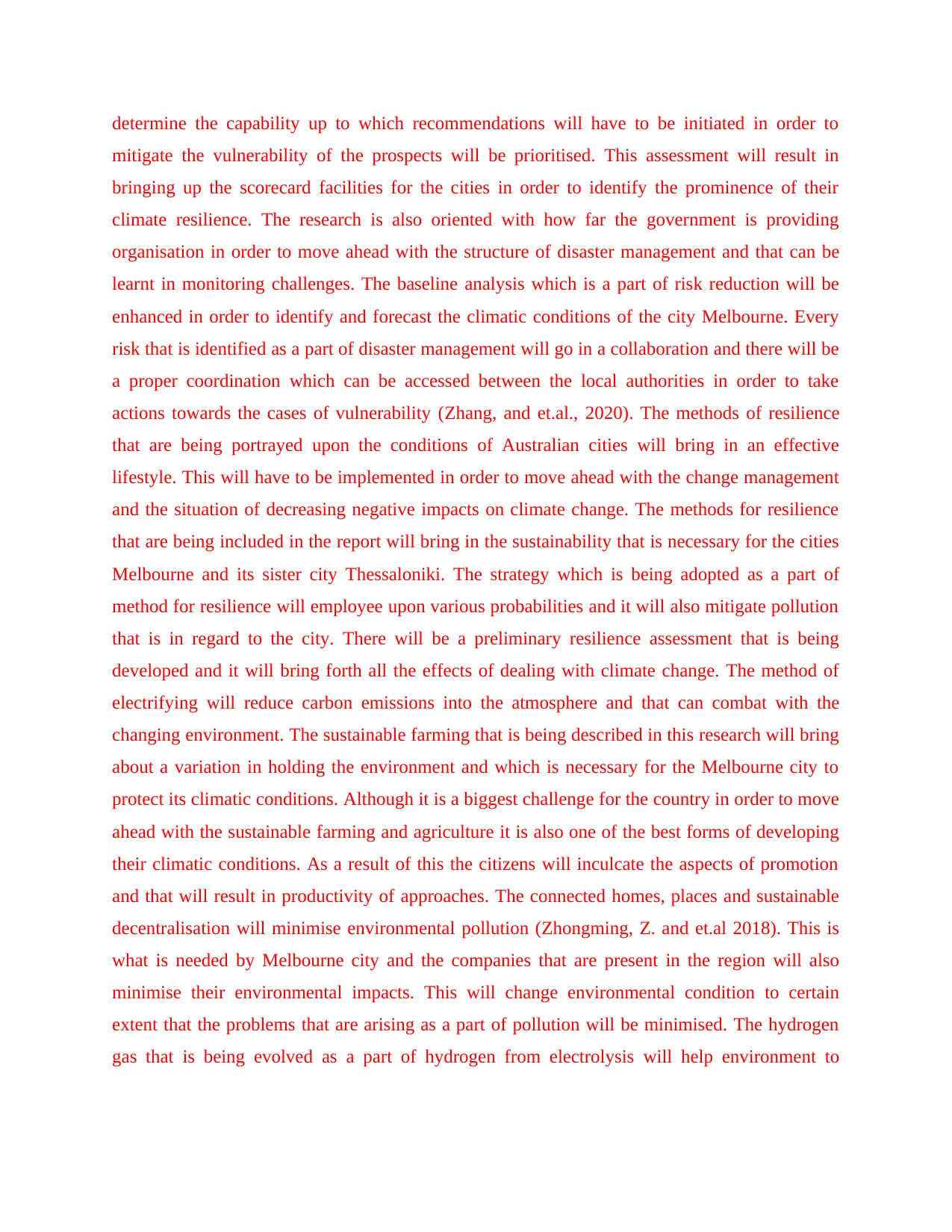
determine the capability up to which recommendations will have to be initiated in order to
mitigate the vulnerability of the prospects will be prioritised. This assessment will result in
bringing up the scorecard facilities for the cities in order to identify the prominence of their
climate resilience. The research is also oriented with how far the government is providing
organisation in order to move ahead with the structure of disaster management and that can be
learnt in monitoring challenges. The baseline analysis which is a part of risk reduction will be
enhanced in order to identify and forecast the climatic conditions of the city Melbourne. Every
risk that is identified as a part of disaster management will go in a collaboration and there will be
a proper coordination which can be accessed between the local authorities in order to take
actions towards the cases of vulnerability (Zhang, and et.al., 2020). The methods of resilience
that are being portrayed upon the conditions of Australian cities will bring in an effective
lifestyle. This will have to be implemented in order to move ahead with the change management
and the situation of decreasing negative impacts on climate change. The methods for resilience
that are being included in the report will bring in the sustainability that is necessary for the cities
Melbourne and its sister city Thessaloniki. The strategy which is being adopted as a part of
method for resilience will employee upon various probabilities and it will also mitigate pollution
that is in regard to the city. There will be a preliminary resilience assessment that is being
developed and it will bring forth all the effects of dealing with climate change. The method of
electrifying will reduce carbon emissions into the atmosphere and that can combat with the
changing environment. The sustainable farming that is being described in this research will bring
about a variation in holding the environment and which is necessary for the Melbourne city to
protect its climatic conditions. Although it is a biggest challenge for the country in order to move
ahead with the sustainable farming and agriculture it is also one of the best forms of developing
their climatic conditions. As a result of this the citizens will inculcate the aspects of promotion
and that will result in productivity of approaches. The connected homes, places and sustainable
decentralisation will minimise environmental pollution (Zhongming, Z. and et.al 2018). This is
what is needed by Melbourne city and the companies that are present in the region will also
minimise their environmental impacts. This will change environmental condition to certain
extent that the problems that are arising as a part of pollution will be minimised. The hydrogen
gas that is being evolved as a part of hydrogen from electrolysis will help environment to
mitigate the vulnerability of the prospects will be prioritised. This assessment will result in
bringing up the scorecard facilities for the cities in order to identify the prominence of their
climate resilience. The research is also oriented with how far the government is providing
organisation in order to move ahead with the structure of disaster management and that can be
learnt in monitoring challenges. The baseline analysis which is a part of risk reduction will be
enhanced in order to identify and forecast the climatic conditions of the city Melbourne. Every
risk that is identified as a part of disaster management will go in a collaboration and there will be
a proper coordination which can be accessed between the local authorities in order to take
actions towards the cases of vulnerability (Zhang, and et.al., 2020). The methods of resilience
that are being portrayed upon the conditions of Australian cities will bring in an effective
lifestyle. This will have to be implemented in order to move ahead with the change management
and the situation of decreasing negative impacts on climate change. The methods for resilience
that are being included in the report will bring in the sustainability that is necessary for the cities
Melbourne and its sister city Thessaloniki. The strategy which is being adopted as a part of
method for resilience will employee upon various probabilities and it will also mitigate pollution
that is in regard to the city. There will be a preliminary resilience assessment that is being
developed and it will bring forth all the effects of dealing with climate change. The method of
electrifying will reduce carbon emissions into the atmosphere and that can combat with the
changing environment. The sustainable farming that is being described in this research will bring
about a variation in holding the environment and which is necessary for the Melbourne city to
protect its climatic conditions. Although it is a biggest challenge for the country in order to move
ahead with the sustainable farming and agriculture it is also one of the best forms of developing
their climatic conditions. As a result of this the citizens will inculcate the aspects of promotion
and that will result in productivity of approaches. The connected homes, places and sustainable
decentralisation will minimise environmental pollution (Zhongming, Z. and et.al 2018). This is
what is needed by Melbourne city and the companies that are present in the region will also
minimise their environmental impacts. This will change environmental condition to certain
extent that the problems that are arising as a part of pollution will be minimised. The hydrogen
gas that is being evolved as a part of hydrogen from electrolysis will help environment to
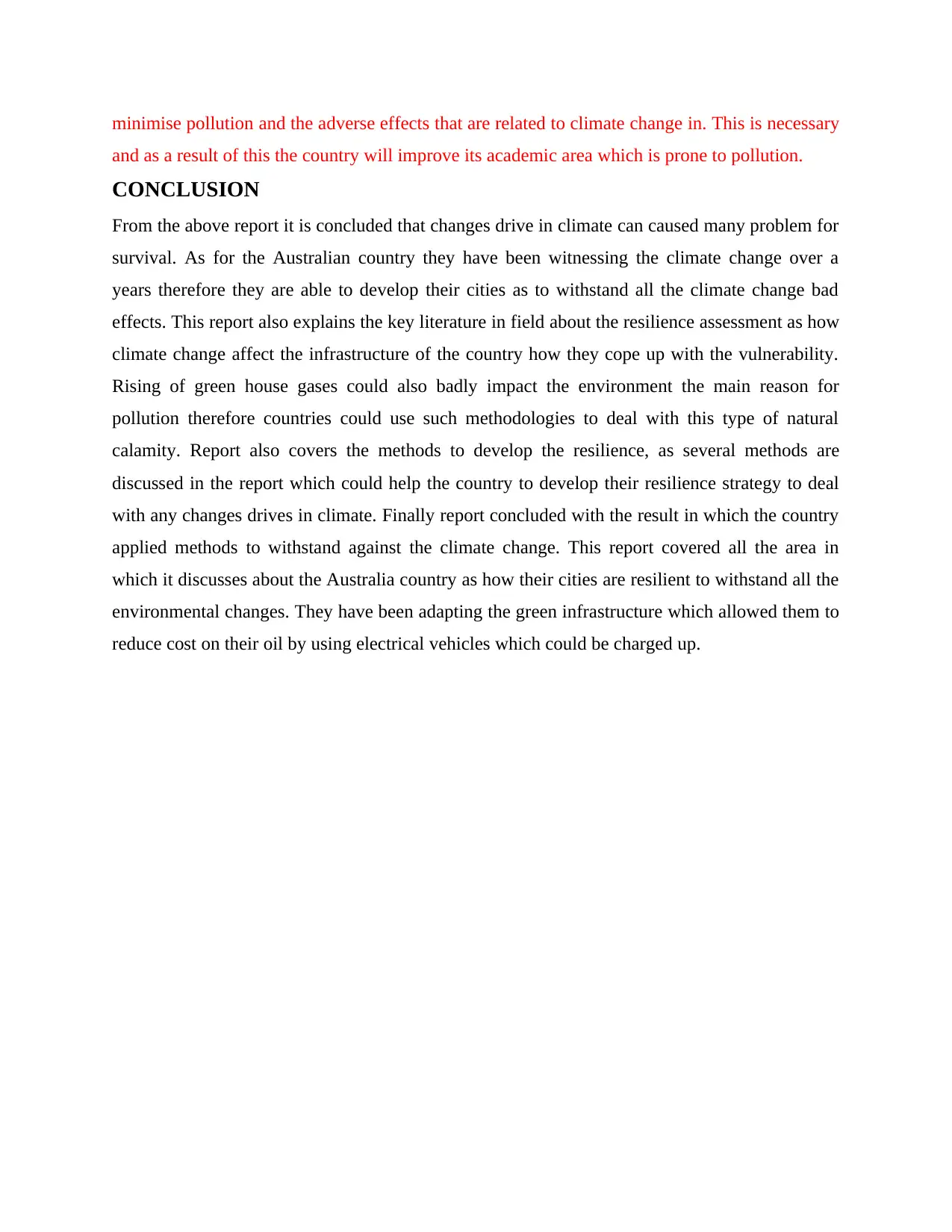
minimise pollution and the adverse effects that are related to climate change in. This is necessary
and as a result of this the country will improve its academic area which is prone to pollution.
CONCLUSION
From the above report it is concluded that changes drive in climate can caused many problem for
survival. As for the Australian country they have been witnessing the climate change over a
years therefore they are able to develop their cities as to withstand all the climate change bad
effects. This report also explains the key literature in field about the resilience assessment as how
climate change affect the infrastructure of the country how they cope up with the vulnerability.
Rising of green house gases could also badly impact the environment the main reason for
pollution therefore countries could use such methodologies to deal with this type of natural
calamity. Report also covers the methods to develop the resilience, as several methods are
discussed in the report which could help the country to develop their resilience strategy to deal
with any changes drives in climate. Finally report concluded with the result in which the country
applied methods to withstand against the climate change. This report covered all the area in
which it discusses about the Australia country as how their cities are resilient to withstand all the
environmental changes. They have been adapting the green infrastructure which allowed them to
reduce cost on their oil by using electrical vehicles which could be charged up.
and as a result of this the country will improve its academic area which is prone to pollution.
CONCLUSION
From the above report it is concluded that changes drive in climate can caused many problem for
survival. As for the Australian country they have been witnessing the climate change over a
years therefore they are able to develop their cities as to withstand all the climate change bad
effects. This report also explains the key literature in field about the resilience assessment as how
climate change affect the infrastructure of the country how they cope up with the vulnerability.
Rising of green house gases could also badly impact the environment the main reason for
pollution therefore countries could use such methodologies to deal with this type of natural
calamity. Report also covers the methods to develop the resilience, as several methods are
discussed in the report which could help the country to develop their resilience strategy to deal
with any changes drives in climate. Finally report concluded with the result in which the country
applied methods to withstand against the climate change. This report covered all the area in
which it discusses about the Australia country as how their cities are resilient to withstand all the
environmental changes. They have been adapting the green infrastructure which allowed them to
reduce cost on their oil by using electrical vehicles which could be charged up.
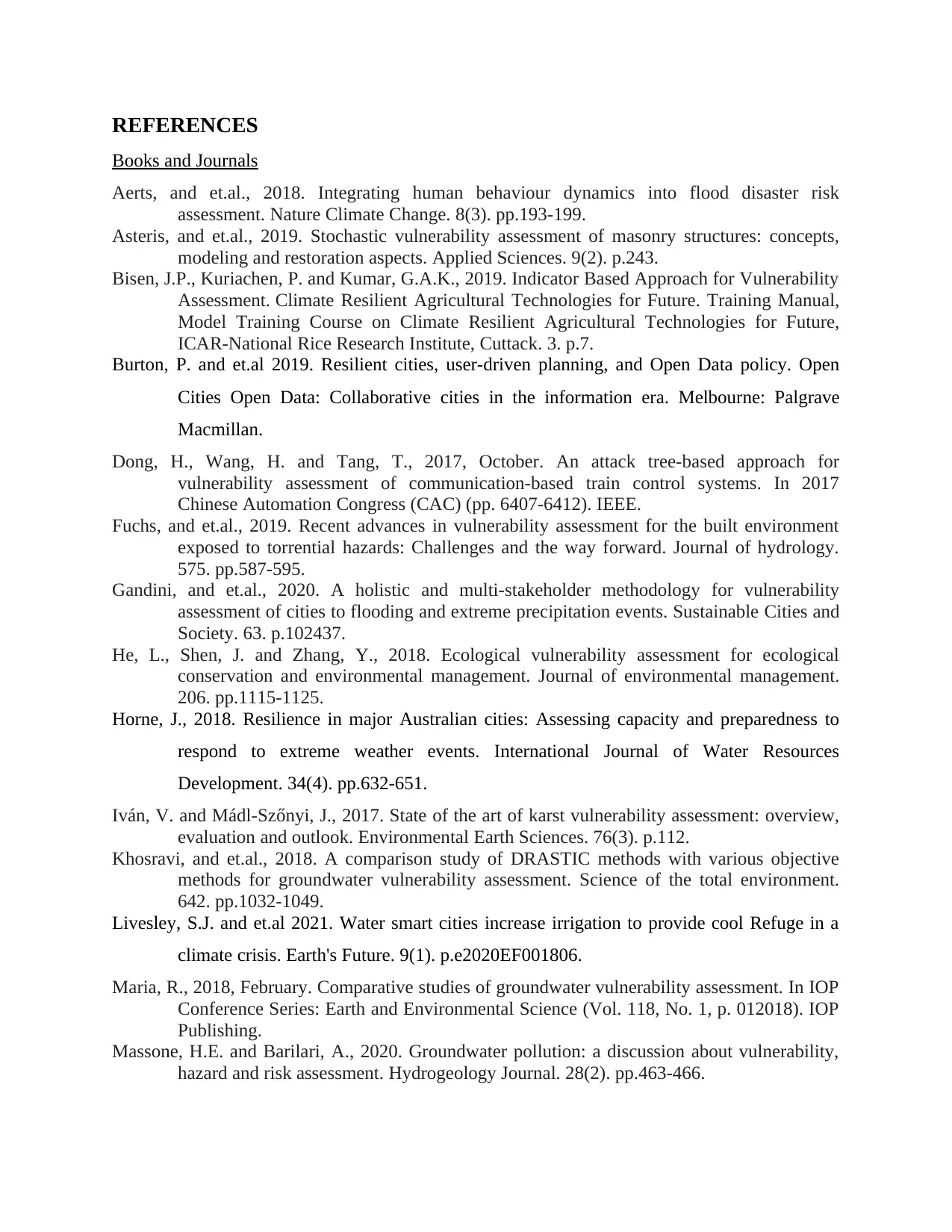
REFERENCES
Books and Journals
Aerts, and et.al., 2018. Integrating human behaviour dynamics into flood disaster risk
assessment. Nature Climate Change. 8(3). pp.193-199.
Asteris, and et.al., 2019. Stochastic vulnerability assessment of masonry structures: concepts,
modeling and restoration aspects. Applied Sciences. 9(2). p.243.
Bisen, J.P., Kuriachen, P. and Kumar, G.A.K., 2019. Indicator Based Approach for Vulnerability
Assessment. Climate Resilient Agricultural Technologies for Future. Training Manual,
Model Training Course on Climate Resilient Agricultural Technologies for Future,
ICAR-National Rice Research Institute, Cuttack. 3. p.7.
Burton, P. and et.al 2019. Resilient cities, user-driven planning, and Open Data policy. Open
Cities Open Data: Collaborative cities in the information era. Melbourne: Palgrave
Macmillan.
Dong, H., Wang, H. and Tang, T., 2017, October. An attack tree-based approach for
vulnerability assessment of communication-based train control systems. In 2017
Chinese Automation Congress (CAC) (pp. 6407-6412). IEEE.
Fuchs, and et.al., 2019. Recent advances in vulnerability assessment for the built environment
exposed to torrential hazards: Challenges and the way forward. Journal of hydrology.
575. pp.587-595.
Gandini, and et.al., 2020. A holistic and multi-stakeholder methodology for vulnerability
assessment of cities to flooding and extreme precipitation events. Sustainable Cities and
Society. 63. p.102437.
He, L., Shen, J. and Zhang, Y., 2018. Ecological vulnerability assessment for ecological
conservation and environmental management. Journal of environmental management.
206. pp.1115-1125.
Horne, J., 2018. Resilience in major Australian cities: Assessing capacity and preparedness to
respond to extreme weather events. International Journal of Water Resources
Development. 34(4). pp.632-651.
Iván, V. and Mádl-Szőnyi, J., 2017. State of the art of karst vulnerability assessment: overview,
evaluation and outlook. Environmental Earth Sciences. 76(3). p.112.
Khosravi, and et.al., 2018. A comparison study of DRASTIC methods with various objective
methods for groundwater vulnerability assessment. Science of the total environment.
642. pp.1032-1049.
Livesley, S.J. and et.al 2021. Water smart cities increase irrigation to provide cool Refuge in a
climate crisis. Earth's Future. 9(1). p.e2020EF001806.
Maria, R., 2018, February. Comparative studies of groundwater vulnerability assessment. In IOP
Conference Series: Earth and Environmental Science (Vol. 118, No. 1, p. 012018). IOP
Publishing.
Massone, H.E. and Barilari, A., 2020. Groundwater pollution: a discussion about vulnerability,
hazard and risk assessment. Hydrogeology Journal. 28(2). pp.463-466.
Books and Journals
Aerts, and et.al., 2018. Integrating human behaviour dynamics into flood disaster risk
assessment. Nature Climate Change. 8(3). pp.193-199.
Asteris, and et.al., 2019. Stochastic vulnerability assessment of masonry structures: concepts,
modeling and restoration aspects. Applied Sciences. 9(2). p.243.
Bisen, J.P., Kuriachen, P. and Kumar, G.A.K., 2019. Indicator Based Approach for Vulnerability
Assessment. Climate Resilient Agricultural Technologies for Future. Training Manual,
Model Training Course on Climate Resilient Agricultural Technologies for Future,
ICAR-National Rice Research Institute, Cuttack. 3. p.7.
Burton, P. and et.al 2019. Resilient cities, user-driven planning, and Open Data policy. Open
Cities Open Data: Collaborative cities in the information era. Melbourne: Palgrave
Macmillan.
Dong, H., Wang, H. and Tang, T., 2017, October. An attack tree-based approach for
vulnerability assessment of communication-based train control systems. In 2017
Chinese Automation Congress (CAC) (pp. 6407-6412). IEEE.
Fuchs, and et.al., 2019. Recent advances in vulnerability assessment for the built environment
exposed to torrential hazards: Challenges and the way forward. Journal of hydrology.
575. pp.587-595.
Gandini, and et.al., 2020. A holistic and multi-stakeholder methodology for vulnerability
assessment of cities to flooding and extreme precipitation events. Sustainable Cities and
Society. 63. p.102437.
He, L., Shen, J. and Zhang, Y., 2018. Ecological vulnerability assessment for ecological
conservation and environmental management. Journal of environmental management.
206. pp.1115-1125.
Horne, J., 2018. Resilience in major Australian cities: Assessing capacity and preparedness to
respond to extreme weather events. International Journal of Water Resources
Development. 34(4). pp.632-651.
Iván, V. and Mádl-Szőnyi, J., 2017. State of the art of karst vulnerability assessment: overview,
evaluation and outlook. Environmental Earth Sciences. 76(3). p.112.
Khosravi, and et.al., 2018. A comparison study of DRASTIC methods with various objective
methods for groundwater vulnerability assessment. Science of the total environment.
642. pp.1032-1049.
Livesley, S.J. and et.al 2021. Water smart cities increase irrigation to provide cool Refuge in a
climate crisis. Earth's Future. 9(1). p.e2020EF001806.
Maria, R., 2018, February. Comparative studies of groundwater vulnerability assessment. In IOP
Conference Series: Earth and Environmental Science (Vol. 118, No. 1, p. 012018). IOP
Publishing.
Massone, H.E. and Barilari, A., 2020. Groundwater pollution: a discussion about vulnerability,
hazard and risk assessment. Hydrogeology Journal. 28(2). pp.463-466.
Paraphrase This Document
Need a fresh take? Get an instant paraphrase of this document with our AI Paraphraser
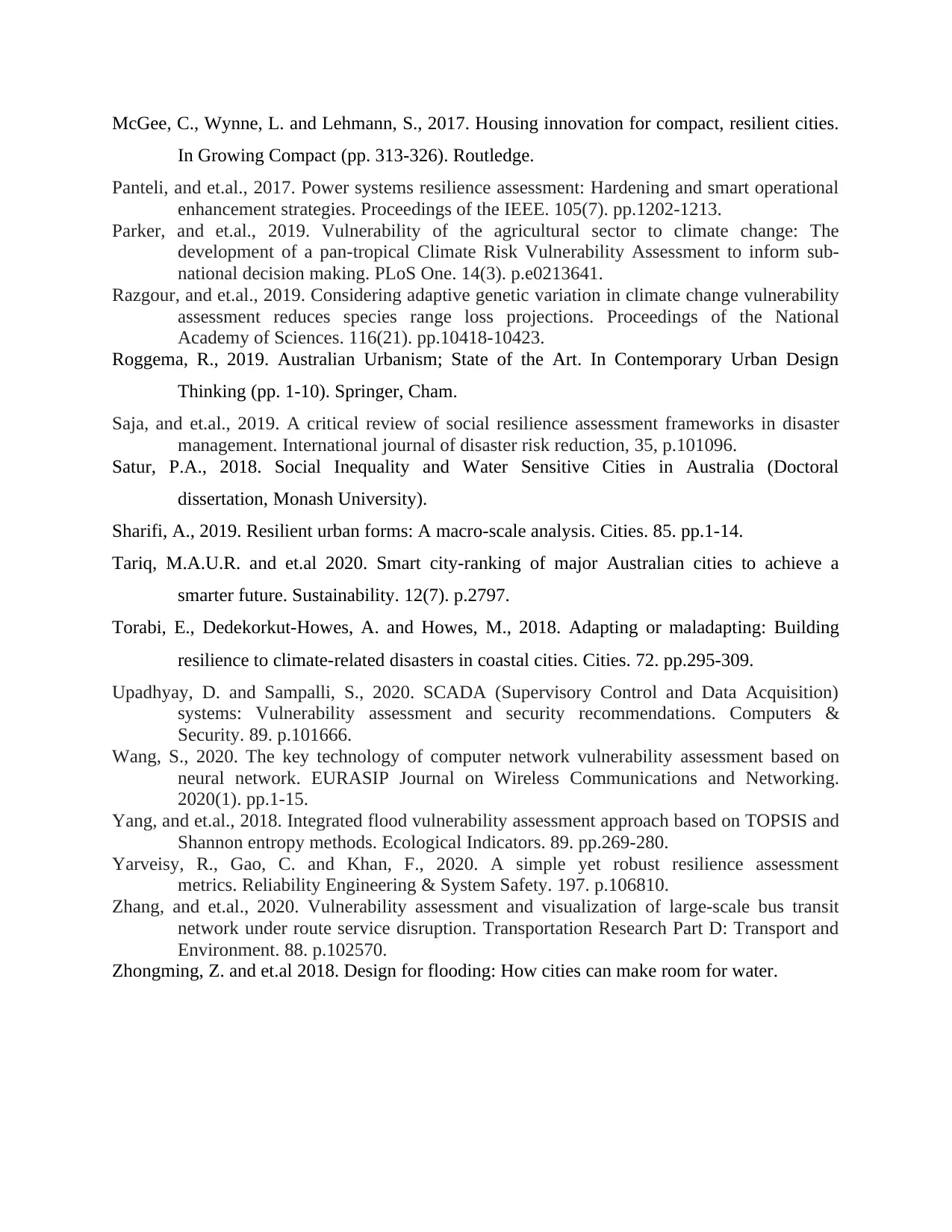
McGee, C., Wynne, L. and Lehmann, S., 2017. Housing innovation for compact, resilient cities.
In Growing Compact (pp. 313-326). Routledge.
Panteli, and et.al., 2017. Power systems resilience assessment: Hardening and smart operational
enhancement strategies. Proceedings of the IEEE. 105(7). pp.1202-1213.
Parker, and et.al., 2019. Vulnerability of the agricultural sector to climate change: The
development of a pan-tropical Climate Risk Vulnerability Assessment to inform sub-
national decision making. PLoS One. 14(3). p.e0213641.
Razgour, and et.al., 2019. Considering adaptive genetic variation in climate change vulnerability
assessment reduces species range loss projections. Proceedings of the National
Academy of Sciences. 116(21). pp.10418-10423.
Roggema, R., 2019. Australian Urbanism; State of the Art. In Contemporary Urban Design
Thinking (pp. 1-10). Springer, Cham.
Saja, and et.al., 2019. A critical review of social resilience assessment frameworks in disaster
management. International journal of disaster risk reduction, 35, p.101096.
Satur, P.A., 2018. Social Inequality and Water Sensitive Cities in Australia (Doctoral
dissertation, Monash University).
Sharifi, A., 2019. Resilient urban forms: A macro-scale analysis. Cities. 85. pp.1-14.
Tariq, M.A.U.R. and et.al 2020. Smart city-ranking of major Australian cities to achieve a
smarter future. Sustainability. 12(7). p.2797.
Torabi, E., Dedekorkut-Howes, A. and Howes, M., 2018. Adapting or maladapting: Building
resilience to climate-related disasters in coastal cities. Cities. 72. pp.295-309.
Upadhyay, D. and Sampalli, S., 2020. SCADA (Supervisory Control and Data Acquisition)
systems: Vulnerability assessment and security recommendations. Computers &
Security. 89. p.101666.
Wang, S., 2020. The key technology of computer network vulnerability assessment based on
neural network. EURASIP Journal on Wireless Communications and Networking.
2020(1). pp.1-15.
Yang, and et.al., 2018. Integrated flood vulnerability assessment approach based on TOPSIS and
Shannon entropy methods. Ecological Indicators. 89. pp.269-280.
Yarveisy, R., Gao, C. and Khan, F., 2020. A simple yet robust resilience assessment
metrics. Reliability Engineering & System Safety. 197. p.106810.
Zhang, and et.al., 2020. Vulnerability assessment and visualization of large-scale bus transit
network under route service disruption. Transportation Research Part D: Transport and
Environment. 88. p.102570.
Zhongming, Z. and et.al 2018. Design for flooding: How cities can make room for water.
In Growing Compact (pp. 313-326). Routledge.
Panteli, and et.al., 2017. Power systems resilience assessment: Hardening and smart operational
enhancement strategies. Proceedings of the IEEE. 105(7). pp.1202-1213.
Parker, and et.al., 2019. Vulnerability of the agricultural sector to climate change: The
development of a pan-tropical Climate Risk Vulnerability Assessment to inform sub-
national decision making. PLoS One. 14(3). p.e0213641.
Razgour, and et.al., 2019. Considering adaptive genetic variation in climate change vulnerability
assessment reduces species range loss projections. Proceedings of the National
Academy of Sciences. 116(21). pp.10418-10423.
Roggema, R., 2019. Australian Urbanism; State of the Art. In Contemporary Urban Design
Thinking (pp. 1-10). Springer, Cham.
Saja, and et.al., 2019. A critical review of social resilience assessment frameworks in disaster
management. International journal of disaster risk reduction, 35, p.101096.
Satur, P.A., 2018. Social Inequality and Water Sensitive Cities in Australia (Doctoral
dissertation, Monash University).
Sharifi, A., 2019. Resilient urban forms: A macro-scale analysis. Cities. 85. pp.1-14.
Tariq, M.A.U.R. and et.al 2020. Smart city-ranking of major Australian cities to achieve a
smarter future. Sustainability. 12(7). p.2797.
Torabi, E., Dedekorkut-Howes, A. and Howes, M., 2018. Adapting or maladapting: Building
resilience to climate-related disasters in coastal cities. Cities. 72. pp.295-309.
Upadhyay, D. and Sampalli, S., 2020. SCADA (Supervisory Control and Data Acquisition)
systems: Vulnerability assessment and security recommendations. Computers &
Security. 89. p.101666.
Wang, S., 2020. The key technology of computer network vulnerability assessment based on
neural network. EURASIP Journal on Wireless Communications and Networking.
2020(1). pp.1-15.
Yang, and et.al., 2018. Integrated flood vulnerability assessment approach based on TOPSIS and
Shannon entropy methods. Ecological Indicators. 89. pp.269-280.
Yarveisy, R., Gao, C. and Khan, F., 2020. A simple yet robust resilience assessment
metrics. Reliability Engineering & System Safety. 197. p.106810.
Zhang, and et.al., 2020. Vulnerability assessment and visualization of large-scale bus transit
network under route service disruption. Transportation Research Part D: Transport and
Environment. 88. p.102570.
Zhongming, Z. and et.al 2018. Design for flooding: How cities can make room for water.

https://thefifthestate.com.au/articles/australian-cities-map-the-road-to-resilience/
https://ndy.com/news/sustainability/sydney-selected-one-worlds-100-resilient-cities
https://resilientmelbourne.com.au/
https://positivepsychology.com/3-resilience-scales/
https://ndy.com/news/sustainability/sydney-selected-one-worlds-100-resilient-cities
https://resilientmelbourne.com.au/
https://positivepsychology.com/3-resilience-scales/
1 out of 15
Related Documents
Your All-in-One AI-Powered Toolkit for Academic Success.
+13062052269
info@desklib.com
Available 24*7 on WhatsApp / Email
![[object Object]](/_next/static/media/star-bottom.7253800d.svg)
Unlock your academic potential
© 2024 | Zucol Services PVT LTD | All rights reserved.





